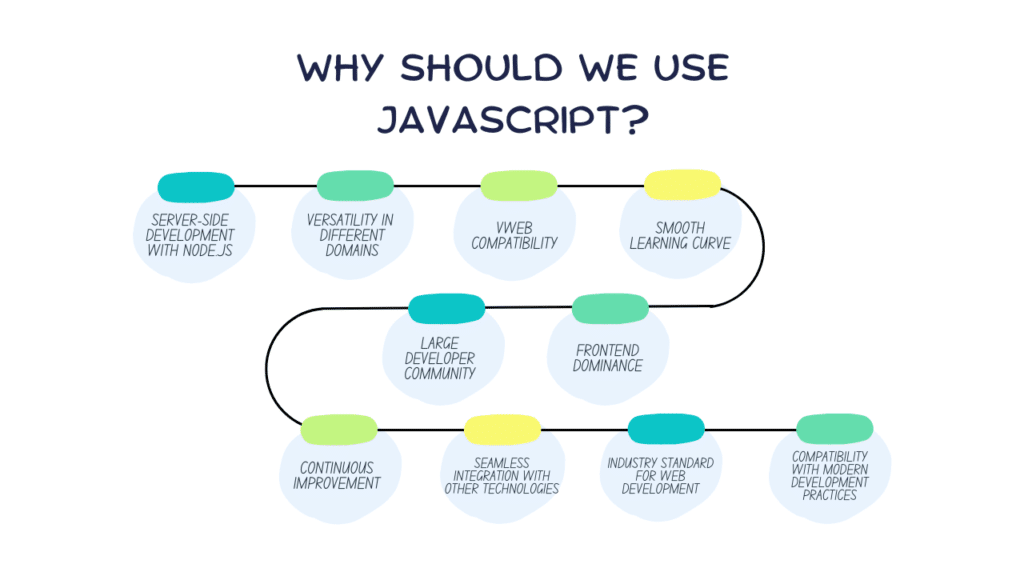From Front to Back: Why is JS the Ideal Choice for Your Project?
Did you know that for over 27 years, JavaScript, a powerful and versatile programming language, has revolutionized the digital landscape, earning the trust and adoption of countless tech giants? From the likes of Google and YouTube to Facebook and LinkedIn, JavaScript has powered some of the world’s most renowned websites and applications.
In 2023, JavaScript remains incredibly popular among developers and highly valued by businesses. It’s unsurprising, considering that 98.6% of all websites (as of mid-2023) use JavaScript. With an impressive arsenal of 1,444,231 libraries, JavaScript has firmly established itself as the go-to language for building interactive and dynamic web experiences. Join us as we embark on a journey into the realm of JavaScript, exploring its remarkable influence and the myriad possibilities it offers for your project.
Why should we use JavaScript?
JavaScript’s popularity stems from simplicity, versatility, and seamless integration with web technologies like HTML and CSS. As web and mobile app development continues to soar, JavaScript has become a must-have skill for developers in the ever-evolving tech industry.

Beyond its widespread usage, JavaScript’s wide broad applicability can be attributed to a myriad of reasons:
- Server-side development with Node.js: JavaScript’s expansion into server-side development through Node.js enables creation of scalable and efficient backend systems, further enhancing its utility and relevance.
- Versatility in different domains: JavaScript’s versatility extends beyond web development, finding applications in various domains such as desktop applications, game development, and even robotics, amplifying its appeal.
- Web compatibility: JavaScript seamlessly works across different web browsers, ensuring broad compatibility and consistent platform performance.
- Smooth learning curve: JavaScript boasts an approachable learning curve, making it accessible to developers of all skill levels. It has an intuitive syntax and extensive resources to facilitate quick adoption and proficiency.
- Large developer community: JavaScript benefits from a vast and active community of developers, fostering collaboration, knowledge sharing, and continuous improvement of the language and its associated frameworks and libraries.
- Frontend dominance: JavaScript’s dominance in frontend development empowers developers to create dynamic and interactive user interfaces, elevating the overall user experience.
- Continuous improvement: JavaScript undergoes regular updates introducing new features and capabilities that cater to evolving developer needs and industry standards.
- Seamless integration with other technologies: JavaScript seamlessly integrates with other technologies, enabling developers to combine it with frameworks, libraries, and APIs for enhanced functionality and productivity.
- Compatibility with modern development practices: JavaScript aligns with modern development practices like modularization, component-based architectures, and asynchronous programming, empowering developers with efficient and scalable coding techniques.
- Industry standard for web development: JavaScript has solidified its position as the industry-standard language for web development, establishing itself as an essential tool for building cutting-edge web applications.
Why is JavaScript so popular for the frontend?
Client-side interactivity
JavaScript is primarily executed on the client side, allowing developers to create interactive and dynamic user experiences directly within the web browser. It enables form validation, animations, real-time updates, and responsive behavior without requiring server-side interactions or page reloads.
Native browser support
All modern web browsers, including Chrome, Firefox, Safari, and Edge, support JavaScript. This widespread support ensures consistent functionality and compatibility across different platforms and devices without additional plugins or installations.
Vast ecosystem of frameworks and libraries
JavaScript has a rich ecosystem of frameworks and libraries that simplify frontend development. Popular frameworks like AngularJS, ReactJS, and Vue.js provide efficient ways to build complex user interfaces, manage states, handle data flow, and enhance productivity. These frameworks offer reusable components, modular architecture, and community support, allowing developers to create sophisticated frontend applications easily.
DOM Manipulation
JavaScript has built-in capabilities to manipulate the Document Object Model (DOM), which represents the structure and content of an HTML page. This allows developers to dynamically modify and update the web page’s elements, styles, and content based on user interactions or changing data, providing real-time feedback and interactivity.
Why is JavaScript so popular in the backend?
JavaScript is not only used for the frontend, but also used by backend developers to write server-side code for handling an application’s logic and database interactions. JavaScript benefits from the rise of Node.js, a runtime environment that allows JavaScript to be executed on the server side. Node.js has revolutionized backend development by providing a lightweight, event-driven, non-blocking I/O model, enabling high-performance and real-time applications. Similarly, JavaScript’s asynchronous nature makes it well-suited for handling concurrent operations and managing multiple connections, which is essential for building efficient server applications.
Altogether, the combination of JavaScript’s versatility, a strong developer community, the emergence of Node.js development, and its ability to handle concurrent operations have contributed to its popularity in backend side.
Why JavaScript is used both in frontend and backend?
JavaScript is ideal for full-stack development because it works seamlessly on web applications’ frontend and backend. Here are some specific examples highlighting why JavaScript excels in full-stack development:
Efficient development
When developers use full-stack JavaScript, they can create a web application using just one programming language for both the frontend and backend. This makes it easier for everyone on the team to understand the project because they use the same language. It brings a sense of unity and clarity, allowing team members to know how the whole application works comprehensively. Besides, having one team handle the entire application promotes productivity and smoother development processes. JavaScript is the connecting link throughout the project, making the development journey efficient and well-coordinated.
Open source
Full-stack JavaScript development contains a range of open-source technologies that are freely available for anyone to use. This characteristic offers development teams a valuable opportunity to tap into the vast storage of existing use cases. Leveraging these established solutions can significantly expedite development and improve overall productivity. Furthermore, the open-source nature of full-stack JavaScript development ensures a cost-effective approach, as there is no need to purchase any proprietary technologies to construct a website. By embracing open-source tools, businesses can maximize resources while achieving robust and feature-rich web applications.
Natural Code Reuse
With JavaScript being used both on the back and frontend, developers can leverage reusable code segments with similar logic and implementation. This approach reduces the amount of code that must be written, resulting in fewer lines of code throughout the project. As a result, full-stack development becomes more efficient, enabling developers to streamline their workflow and expedite the development process. Further, code reuse simplifies maintenance and updates, as changes to reusable code are automatically reflected in multiple application areas. It improves code consistency, reduces the likelihood of bugs, and facilitates easier collaboration among developers.
Cost saving
Choosing JavaScript for full-stack development brings significant cost-saving benefits. Usually, a technical team consists of a backend and frontend developer. When selecting a full-stack team, a minimal team is one developer who can efficiently handle it. As the full-stack team gains expertise, they become more productive and accomplish more work in each sprint, allowing businesses to achieve their goals with fewer team members and reduce costs. For larger applications, microservice architecture and micro-frontends enable multiple teams to work simultaneously on different parts, optimizing resources and increasing productivity.
Time-saving
Full-stack developers also save time. They can implement complete features faster than specialized developers by directly testing solutions within the application. This minimizes delays and improves communication, resulting in significant cost reductions. Even without exceptional programming skills, reduced downtime and enhanced communication efficiency contribute to overall cost savings in full-stack development projects.
Conclusion
So, is JavaScript a good choice for your project? Definitely, yes. According to the most recent survey from Statista, JavaScript is the most used programming language among developers, as 65% of all developers are actively engaged in working with JavaScript. JavaScript has a massive community of around 17.4 million software developers. With such a vast talent pool, locating and onboarding new developers becomes significantly easier when it comes to finding skilled developers for your project.
Its credibility is also high. When industry titans like Microsoft, Amazon, Google, or eBay embrace the prowess of a full-stack JavaScript framework for their web development needs, it doesn’t leave any doubts about the efficacy of this approach. After all, the triumphs of these esteemed companies speak volumes and serve as resounding endorsements for the full-stack JS paradigm.






